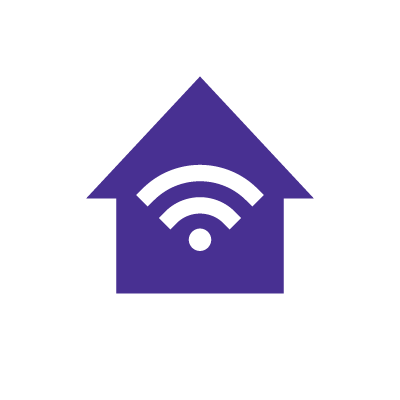How many eeros do I need?

Since its inception, eero has been one of the leaders in networking. Initially created for military and academic settings, eero has shifted focus to improving WiFi coverage and performance within residential homes, especially as the number of internet-connected devices has increased.
So, how many eeros do you need?
Depending on your home’s size and layout, you may find you need to combine eero devices in order to create an optimized mesh network.
We recommend the following:
- Small homes and apartments: Typically, one to two eeros will be sufficient to provide adequate signal throughout the living space.
- Most Homes: Homes with two floors will benefit from two eeros to ensure comprehensive WiFi coverage throughout the home.
- Larger Homes: For larger homes, or homes with more than two floors, three eero devices are recommended to achieve the best WiFi connectivity and coverage.
With every iteration of eero devices and software updates, eero adapts to the needs of the consumer, increasing speed, coverage and security. In this article, we’ll examine how many eeros you really need to integrate a mesh network into your home or apartment.
What you'll learn:

Mesh WiFi with eero Secure
Enhanced Whole Home WiFi uses multiple routers (or eeros®) to boost range, speed, and stability, while eero Secure, included at no extra cost, offers parental controls, ad blocking, and internet backup for constant connectivity.
What is an eero mesh network?
Simply put, eero differs from traditional routers primarily through its eero mesh WiFi, which provides many advantages over a conventional single-router setup. Regular routers often struggle to deliver consistent coverage throughout a home, particularly in larger or multi-story buildings, leading to areas with weak or no signal.
Developed by eero, TrueMesh technology allows multiple eero devices to work together seamlessly to cover every corner of your home with a strong and reliable WiFi signal.
With an eero mesh network, you’ll benefit from:
- Extended Coverage: eero uses multiple devices or nodes to create a mesh network that extends WiFi coverage throughout your home. This setup ensures that areas far from the main router still enjoy strong WiFi connectivity. You can easily expand the coverage by adding more eero devices as needed.
- Self-Configuring and Healing: eero networks are self-configuring and can automatically repair themselves. If a node fails, the network reroutes data through other nodes to maintain stable connectivity without user intervention. This is a significant step up from traditional routers, which can require manual reconfiguration if the network setup changes.
- Simplified Management: Setting up eero WiFi is straightforward, thanks to its companion app. The app guides users through setup and allows for easy management of network settings, such as guest access and family profiles, directly from a smartphone. This contrasts with the often complex web interfaces used by traditional routers.
- Continuous Improvement: eero systems are designed to improve over time. They receive automatic software updates that not only enhance security but also introduce new features and optimize performance without any need for user intervention.
These features make eero particularly suitable for users seeking an easy-to-manage, robust and extendable WiFi solution that adapts to the varied layouts and sizes of modern homes.
WiFi that just works!
WiFi plans for any home
Tiny, large or somewhere in between; find WiFi coverage to fit any space. Blanket your entire home with a fast and ultra‑reliable connection.

What to consider when determining the number of eeros
There are many variables to consider when choosing the right equipment for your home or apartment. Make sure to factor in the size and layout of your home, your internet usage or internet habits, as well as the eero models and specifications you’re considering.
1. Size and layout of your home
Without a mesh network, like eero, your WiFi’s performance depends on the size and layout of your home. For example, your WiFi network in a long single-story home may have issues reaching the other side of the house. Or, in a townhouse with multiple stories, your WiFi may have issues reaching the top of the home.
Using mesh networks, your eero coverage area is no longer limited to the size or layout of your home.
However, you may need to design your mesh network with your home in mind. When doing so, make sure to note any dead zones or areas where you’ll want WiFi, and keep reading to learn the best practices for bringing an eero into the home.
Learn more: Not sure how to set up WiFi in your home or new apartment? Tips and techniques in these articles will get you started.
Find your speed
What speed do you need?
Maybe you just need the essentials—or maybe you need to unleash the ultimate internet speed. Explore your options to get the best experience for every device in your home.

2. Internet usage
Additionally, you will want to consider the users within your home and what their internet habits are.
Here’s how you can effectively assess and plan for your household’s internet needs:
- Streaming: Video streaming is one of the most bandwidth-intensive activities. Consider how many people in your household stream video content simultaneously and the quality of the content they prefer.
- Gaming: Online gaming generally requires a stable connection with low latency rather than high bandwidth. If multiple household members play online games, especially competitive multiplayer games, prioritize a stable connection with low latency.
- Smart devices: Smart home devices such as smart speakers, security cameras, thermostats, washing machines and others typically don’t require a lot of bandwidth individually. However, the cumulative effect of many devices can be significant.
- Number of users and devices: The more devices connected to the network, the greater the total bandwidth needed. Count all devices that connect to the internet, including mobile phones, tablets, laptops, smart TVs and any IoT devices.
- Usage patterns: Consider the peak usage times in your household. For example, evening hours might see the highest usage if all family members are home and using the internet. Bandwidth needs to be sufficient to handle peak load without slowing down.
- Download and Upload Speeds: Most activities are heavy on downloads, but if anyone in your household uploads large files, does live streaming, or uses cloud services extensively, consider an internet plan with higher upload speeds.
Mesh network systems like eero can enhance coverage and performance across larger homes or homes with layout challenges. Before investing in eero, consider upgrading your modem in order to make sure the mesh network can distribute the signal most effectively.
Switch & save
Astound is the #1 cable ISP
Stream live content, work, surf, game and connect to multiple devices with speeds up to 1500* Mbps through our ultra‑reliable fiber‑powered network.*

3. All eero model and specifications
Each eero model is designed with specific security features and capabilities to enhance your online experience, whether you’re streaming high-definition content, engaging in competitive gaming, or managing a smart home ecosystem.
Let’s review the latest* eero products on the market.
- eero Max 7: The latest model offering WiFi 7 technology, capable of speeds up to 10 Gbps, designed for homes with numerous devices and multi-gigabit internet plans. It features 320 MHz channel bandwidths to reduce latency.
- eero Pro 6E: This model supports WiFi 6E, providing up to 2.3 Gbps across a 2,000 sq. ft. area per device, without dedicating the 6 GHz band solely to backhaul, allowing direct use of this bandwidth by devices.
- eero 6+: An economical choice that supports up to a gigabit speed and 1,500 sq. ft. coverage per device. It doubles as a smart home hub compatible with Zigbee and Alexa.
- eero Pro 6: Utilizes WiFi 6 to support fast speeds and connectivity for over 75 devices with a coverage of up to 2,000 sq. ft. per device.
- eero 6: A WiFi 6 router offering speeds up to 900 Mbps and 1,500 sq. ft. of coverage per device, featuring a built-in smart home hub.
- eero: A compact and economical router providing up to 1,500 sq. ft. of coverage, suitable for expanding an existing network with additional Ethernet connectivity.
- eero 6 Extender: An add-on device that extends coverage by 1,500 sq. ft. per unit within an eero WiFi 6 network.
- eero Beacon: A plug-in unit to extend the coverage of an existing mesh WiFi network easily without the need for Ethernet ports.
*Information was accessed from eero.com in 04/2024
eero placement for maximum coverage
Ensuring optimal WiFi coverage in your home requires strategic eero placement. Correct placement of these devices can dramatically improve the consistency and reliability of your internet connection, eliminating dead spots or weak signals.
Let’s review best practices for setting up your eero devices, including central placement, height and the importance of avoiding obstructions to ensure you get the best possible internet experience.
Before diving into setting up your eero, make sure to maximize your router and modem with these tips:
Consider primary eero placement
Position your gateway eero (the one connected to your modem) in a central location within your home if possible. This helps distribute the WiFi signal more evenly throughout your space.
Avoid obstructing your eeros
Place eeros away from large metal objects and appliances like refrigerators and microwaves that can cause interference. Also, avoid thick barriers such as brick walls as they can weaken the WiFi signal.
Keep your eeros at a consistent height
Mounting your eeros at a height halfway between the floor and ceiling can help improve the signal distribution, as eero devices tend to radiate their signal more effectively at this height.
Reduce distance between your eeros
Ideally, eero devices should be no more than 50 feet apart to maintain a strong wireless connection between them. This distance might need adjustment based on the specific layout and construction materials of your home.
Keep your eeros visible
Keep eeros out in the open rather than hidden in cabinets or behind other objects to allow for better signal transmission.
Experiment with your eeros
As every home is unique, you may need to experiment with different placements to find the optimal spots for your eeros. The eero app can guide you through this process to help ensure you’re getting the best coverage possible.
Check for service
Get internet service that delights
Astound is ranked among the best for overall satisfaction*. When it comes to download speed and quality, Astound more than delivers.

Calculating the number of eeros needed
To calculate the number of eero devices needed for your home, you should consider several factors including the size of your home, its layout and specific coverage needs. Follow our process below to make sure you start with the right amount of eeros for your home.
- Determine your square footage: Start by measuring the square footage of your home. This measurement will guide the number of mesh nodes required, as each node covers a certain area. For example, different eero devices cover anywhere from 1,500 to 2,200 square feet, but this can vary depending on the specific device and environmental factors like wall materials and floor layouts.
- Consider layout and floors: If your home has multiple floors or a complex layout, you may need additional eeros to ensure there are no dead zones. Mesh systems are particularly beneficial for multi-story homes because they can maintain strong signal strength across different levels and rooms.
From here, you’ll have a good idea of how many devices you’ll need to start with. Once your eero network is up and running, perform tests and adjustments to make sure that your eero network is optimized for your home. You can add eeros to your home network and follow the steps below to get an accurate number.
- Adjust to your needs: Place your eeros strategically in areas where WiFi usage is heaviest or where your current setup shows weak signal. Placement of eeros can impact the effectiveness of your mesh network.
- Test and optimize: After setting up the nodes, test the network with a WiFi signal strength tool through eero’s app. This will help you identify any areas where additional nodes may be necessary.
After you’re done adjusting and testing your mesh WiFi network, you’ll know whether or not you need to add additional nodes from how the signal performs. Remember, the flexibility of mesh networking allows for adjustments, so you can add more nodes later if your initial setup doesn’t fully blanket your home.
Conclusion
eero’s mesh WiFi systems offer a versatile and robust solution for enhancing internet connectivity across various home sizes and layouts. From small apartments to multi-story homes, the right combination of eero devices can be tailored to meet specific coverage needs, ensuring reliable WiFi throughout your living space.
With features like TrueMesh technology, self-configuring capabilities, and continuous software and security updates, eero simplifies network management and adapts to the needs of your household’s WiFi network.
Astound offers eero as part of our Whole Home WiFi solution. A Whole Home WiFi subscription includes one eero base and one eero beacon/device. Each additional eero device is an additional charge per month, per device. eero Secure is included as part of the basic subscription and eero Plus is available for an additional monthly charge.
Build your plan
Your perfect plan is just a click away
Get the speeds, WiFi, mobile and TV plans you need all at an affordable price. Bundle your services with Astound and see how much you can save.

Frequently asked questions
Can you have too many eeros in a house?
However many eeros you may need depends on your house’s layout and your pre-existing eero configuration. We recommend starting with two to three eeros in order to benefit from mesh networking, and then adding new eeros if you find you still have dead zones.
Does the eero speed up WiFi?
Products like eero cannot increase the speeds that your ISP is sending. However, if your speed is slowed due to old equipment or outdated WiFi standards, eero can possibly help with speeds.
Does eero replace my router?
Yes, eero replaces your router. It doesn’t replace your modem, however. Simply plug eero into your existing fiber, cable or DSL modem. Have a combination modem/router? No worries. Just use it as a modem, and disable the routing function by putting it in bridge mode.
How many devices can each eero handle?
It depends on the model. An eero Max 7 can handle over 200 devices. An eero 6+ can support over 75 devices. Finally, an eero pro 6E can support over 100 devices. For best performance, particularly when the devices are engaged in bandwidth-intensive activities such as streaming, it is recommended to limit the number of connected devices to 30 per eero.
Create your perfect internet plan
Get the internet speed, WiFi, TV and mobile that’s just right for you.
*Internet speeds may vary & are not guaranteed. Certain equipment may be required to reach advertised speeds. DOCSIS 3.1 modem with 2.5GE physical LAN port is required for 1 Gigabit speeds and higher. See astound.com/yourspeed for why speeds may vary. To view Astound’s FCC Network Management Disclosure see astound.com/policies-disclaimers. Limited time offer, subject to change without notice. Advertised promotional price valid for duration of the stated promotional period from time of service activation. Regular rates apply after promotional period ends. Equipment not included and is extra. Modem required for Internet service. Enhanced Wi-Fi or Whole Home Wi-Fi (eero) not included and is add’l. Offer includes a monthly discount for enrollment in both automatic payments (autopay) & paperless billing (e-bill). Discount of $10 applies with automated bank account deduction or a discount of $5 applies with automated credit/debit card payment. Valid email address required. Must complete enrollment in autopay and e-bill within 30-days of placing the order. Without enrollment, the discount does not apply. Discount appears on bill within 3 bill cycles after enrolling. If either autopay or e-bill is canceled, services are changed, or the account is not in good standing, then the monthly discount will be discontinued. Offer valid only for new residential Astound customers or previous customers with an account in good standing who have not had Astound service within the last 60 days. Any add’l services, equipment, premium channels & other tiers of service are subject to an add’l charge & regular increases. A one-time activation fee of $14.99 (in addition to any installation fees) will be charged & is subject to change. Add’l fees apply for taxes & surcharges, and are subject to change. WA RESIDENTS: unless otherwise specified, price does not include a 2% Regulatory Administration Fee. For details about taxes, fees & surcharges visit astound.com/fees. No early termination fees apply in the event service is terminated in advance of the promotional end date. Customer is responsible for any accrued service charges in the event service is canceled. Subject to credit check. Not all services & speeds are available in all areas. A multi-product discount may be available to qualifying addresses with a subscription to mobile, TV, and 600 Mbps Internet or higher. Discounts will be reflected in your order cart at time of purchase, if available. Other restrictions may apply. All services are governed by the Astound Customer Terms & Conditions that can be found at astound.com/policies-disclaimers. © 2025 Radiate HoldCo, LLC d/b/a Astound Broadband. All rights reserved.
While we have made every attempt to ensure that the information contained in this site has been obtained from reliable sources, Astound is not responsible for any errors or omissions, or for the results obtained from the use of this information. All information in this site is provided “as is”, with no guarantee of completeness, accuracy, timeliness and without warranty of any kind, express or implied, including, but not limited to warranties of performance, merchantability and fitness for a particular purpose. Certain links in this site connect to other websites maintained by third parties over whom Astound has no control. Astound makes no representations as to the accuracy or any other aspect of information contained in other websites.
eero Plus is available for an additional $9.99/month and requires subscription to whole home WiFi powered by eero.

















